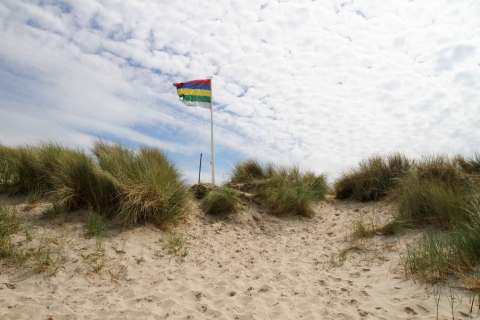
Sense of Place
— Pilot project at Oerol Festival
Learn about our pilot project for 'To See A World in a Grain of Sand' which occurred on the island of Terschelling during the 2017 Oerol Festival in accordance with the theme, Sense of Place.
Have you ever truly looked at a grain of sand? Imagined it as a small part of the world, coming from somewhere, going someplace, with its very own story to tell? To See a World in a Grain of Sand tells stories of time, place, and our profound connection to the world we live in. From a hot and dry desert to a cold and snowy mountain; a skyscraper in a bustling city to an archaeological ruin; an invisible political border to a vast and open landscape; an excavated gold mine to the bottom of an ancient seabed; a place of civil unrest to a serene holiday island. The analysis of sands collected by people from all across the earth reveals hidden narratives in the varied colours and textures of glass fused from 'wild' sands. When these geographical diversities become visible, it becomes clear that sand carries not only ecological significance, but powerful social and political histories.
This ongoing project investigates sand as an incredible natural resource by inviting people from all over the world to send us a sample from their favourite location. The sand is then melted into a small glass sample that reveals the unique colours embedded within that very place, and becomes a part of our expanding collaborative archive and touring exhibition. Join us!
www.aworldofsand.com
of movement, erosion, and transformation.
By melting diverse sands into glass, we reveal the unique colours and textures of the world. We explore the origins and stories of both sand and people from all corners of the globe.
Sand: A Journey Through Science and the Imagination explains, “Sand is anything but ‘just tiny little rocks’; sand is one of our planet’s most ubiquitous and fundamental materials and is both a medium and a tool for nature’s gigantic and ever-changing sculptures. Because, as William Blake recognized– ‘To See a World in a Grain of Sand’– every sand grain has a story to tell of the present and the past. Without it, our world — both on a global scale and on the scale of our everyday lives — would be dramatically different.” Welland’s work has greatly impacted the way that we discern and understand the importance of sand in our world. As he so eloquently put it, “there are worlds to see in a grain of sand, and countless grains to see in our world.” According to Welland, "Lonny and Nadine’s works are powerful evocations of our often forgotten but intimate relationships with the primary materials of our planet and our lives. The deceptively simple act of transforming sand into glass reveals stories of the grains themselves and their dazzling diversity, stories of deep time and endless change."
We are passionate about sharing the wonders of everyday things that normally go unnoticed. You can see this celebration and recognition in all aspects of our work. The greater objective of ‘To See a World in a Grain of Sand’ is to create stronger ties between the earth’s materials and living communities. As people learn about their surroundings, they begin to identify more deeply with place. Sand is a universal and testimonial material that touches all people from all walks of life. By understanding the journeyof sand, we shall develop a deeper understanding of the world around us: the world in a grain of sand.
Collect a 50cl (500ml) bottle of sand from your favourite location and take a photo that best describes the area. This could be of the terrain, plant life, trees or landscape. Use your mobile device to take note of the GPS coordinates or send us the precise address or location!

